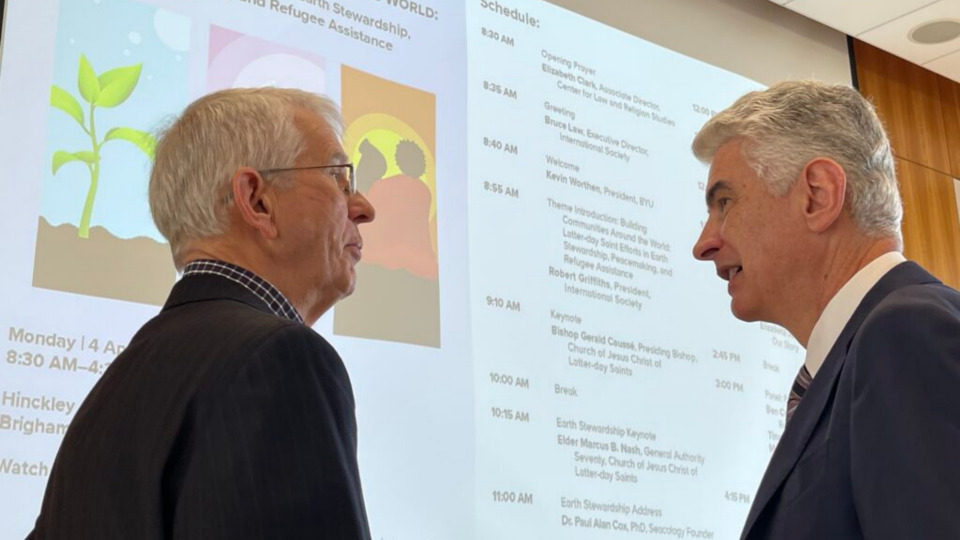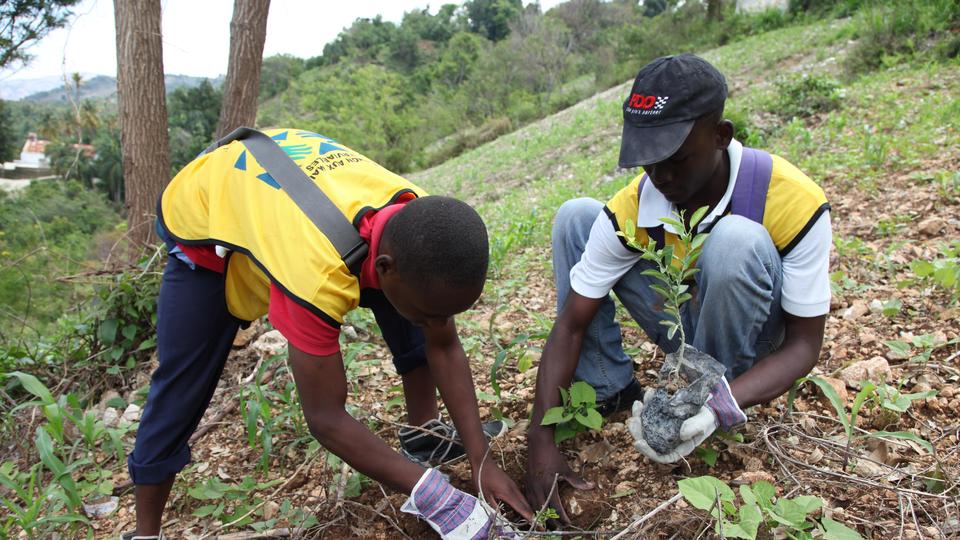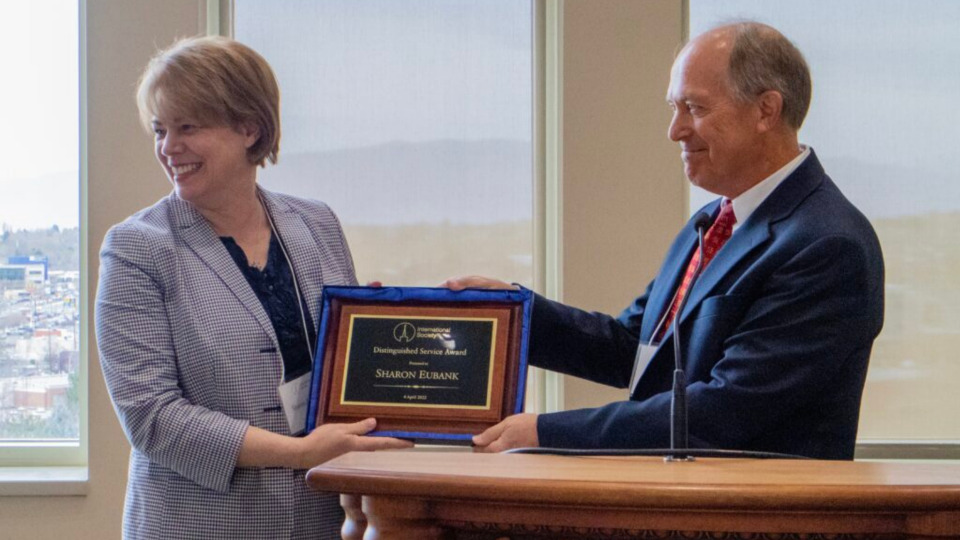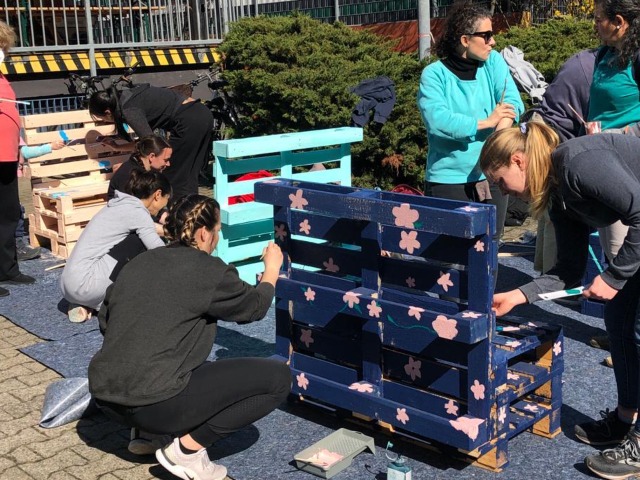
Causse
Presiding Bishop Gérald Caussé visits after the International Society’s annual conference at Brigham Young University in Provo, Utah, on Monday, April 4, 2022. Photo by Tad Walsh, courtesy of Church News. Copyright 2022 Deseret News Publishing Company.This story appears here courtesy of TheChurchNews.com. It is not for use by other media.
By Tad Walsh, Church News
Jesus Christ’s impact on God’s children is a paradox of service that models ways Latter-day Saints can serve others in the modern world, Presiding Bishop Gérald Caussé said this week at Brigham Young University in Provo, Utah.
“Consider how Christ’s teachings during His mortal sojourn transcended both space and time — having application to all lands and peoples in every era — and yet His ministry took place among an astonishingly small segment of the earth’s geography and population,” he said. “He spoke the local language, lived the local culture and participated in local events and ceremonies like weddings.”
His practice of loving everyone was radical in His time, from conversing with the Samaritan woman at the well to healing untouchable lepers, from dining with publicans to defending the woman taken in adultery.
“All who were excluded by society found a welcome place in his company,” he said. “Can we not see through His example that strong communities are never achieved by ignoring or isolating strangers or those who seem weak, different or misplaced?”
Bishop Caussé said Christ’s example is more needed now than ever. He said Latter-day Saints have a responsibility as Christ’s disciples to kindle His love within their communities.
Church culture, he added, is intended to be inclusive, not exclusive, to look outward instead of inward.
“The Lord invites us to be conscious of the broader world in which we live — something which the increased worldwide connectivity now facilitates — and, at the same time, to stay rooted and engaged within our immediate communities. In other words, He expects us to form and strengthen associations on both a global and local scale.”
The Savior showed us the perfect example of how to do this today, Bishop Caussé said during his presentation to the International Society, a global network for Latter-day Saint professionals with international interests from business to development to Church growth, during the group’s annual conference on Monday, April 4.
The Church also exemplifies this pattern, from the prophet down to individual members, he said.
“We are led by a prophet who is one of the greatest ambassadors for peace and harmony in the world today. Throughout his apostolic ministry, President Russell M. Nelson has developed friendships and opened doors among nations, cultures and communities that might previously have been deemed impossible. He has led the Church in becoming known as a key voice in promoting brotherhood, mutual respect and religious freedom,” he said.
Members around the world are following these models, he said. He shared examples of wards, stakes, areas and missionaries doing service both in their larger communities and in their local areas.

Haiti trees
Young Mormon Helping Hands volunteers plant trees on a Haiti hillside2013 by Intellectual Reserve, Inc. All rights reserved.- In Haiti, members have planted 120,000 trees over the past decade.
- In the United States, members engaged in ward- and stake-level blood drives and contributed more blood to the American Red Cross than any other group, the organization’s CEO said last year.
- In Wisconsin, the Milwaukee Wisconsin North Stake joined with local Muslim and Episcopalian congregations last fall to clean up 20 blocks in one of the city’s neighborhoods.
- In Brazil, missionaries and Brazil Area leaders accepted and helped integrate 10,000 Venezuelan member refugees into their wards and branches over the past four years.
“The knowledge provided by the gospel that we are all children of an Eternal Father motivates us to be more sensitive to the brotherhood and sisterhood that should exist among the peoples of the earth,” Bishop Caussé said.
It is motivation to seek to engage in service beyond one’s immediate sphere of influence, he said.
“The fact that you are a member of this international society presupposes a longing on your part to cast your influence across the world. My encouragement to you would be to act on those ‘macro-level’ desires, to use the modern blessings of technology and travel to extend your efforts for good far and wide,” he said.
“At the same time,” he added, “I would ask you to not lose sight of the reality that — as with the mortal Savior — some of the most profound and lasting impacts you may ever have could be upon those with whom you associate individually at the ‘micro-level’ — those within your families, wards, neighborhoods and local communities.”
Today, members across Europe are helping fellow members and others among the refugees from armed conflict in Ukraine, said Bishop Caussé and Latter-day Saint Charities Director Sharon Eubank.

Causse
Sister Sharon Eubank, second counselor in the Relief Society General Presidency and director of Latter-day Saint Charities, is presented with the International Society’s distinguished service award during the society’s conference at Brigham Young University in Provo, Utah, on Monday, April 4, 2022. Photo by Tad Walsh, courtesy of Church News. Copyright 2022 Deseret News Publishing Company.The International Society presented Sister Eubank, Second Sounselor in the outgoing Relief Society General Presidency, with its distinguished service award.
She said the Church is following Bishop Caussé’s concept of a dual approach as it responds to the Ukraine refugee crisis. It is providing aid at an international level and at a micro-local level.
Latter-day Saint Charities has 30 projects underway. That includes proving $5 million in food to people in and around Ukraine, Sister Eubank said. The conflict has displaced nearly 25% of Ukraine’s population.
“We are buying food in Europe, trucking it through those bordering countries and getting it into the pipeline that is going into the cities, and we’re letting the government of Ukraine do the distribution, as they should,” she said.
Meanwhile, ward and stake councils across Europe are mobilizing individually and as part of the area to provide aid to individuals.
Ministering to all and to the one is the pattern after which the Church is organized, Bishop Caussé said. It is the Savior’s pattern.
“One of the great paradoxical but highly comforting truths of the gospel,” Bishop Caussé said, “is that even though the Lord’s love and mercy are so vast as to encompass all — the full infinity of His creations — it is nonetheless infinitesimal in its reach, touching every one of His children in an amazingly intimate and individual way, as if he or she or us — you and me — were the only person on earth.”
Copyright 2022 Deseret News Publishing Company.
